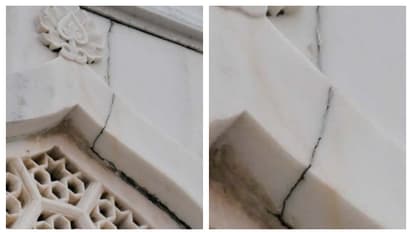Iconic Taj Mahal faces time’s wrath: More cracks appear, Quranic versus fade, precious gems erode due to rain

Synopsis
The iconic Taj Mahal, one of the world’s most celebrated monuments, is now showing visible signs of distress following a week of relentless rainfall in Agra. Multiple cracks, water damage, and erosion are evident across various parts of the structure, as documented in videos and images accessed by The Times of India.
The iconic Taj Mahal, one of the world’s most celebrated monuments, is now showing visible signs of distress following a week of relentless rainfall in Agra. Multiple cracks, water damage, and erosion are evident across various parts of the structure, as documented in videos and images accessed by the Times of India.
Shakeel Chauhan, national general secretary of the Tourist Guide Federation of India, voiced grave concerns over the degradation of this architectural wonder. "Doors surrounding the main dome are inscribed with verses from the Quran in Arabic, the letters of which have worn away," Chauhan stated, drawing attention to the fading grandeur.
The precious inlaid stones, once vibrant through the meticulous pietra dura technique, are also succumbing to the passage of time. "In the western direction, stones from the floor in front of the royal mosque have chipped off. Damages can be seen on parts of the main mausoleum and walls of the iconic dome."
The alarm doesn’t stop there. Deepak Dan, president of the Tourist Guides Welfare Association, took a more direct stance, questioning the authorities responsible for the monument’s upkeep. “What study has the ASI (Archaeological Survey of India) conducted to claim there are no structural issues with the monument?
Taj Mahal is a world-acclaimed monument, and any negative publicity spreads fast, damaging the image of the nation as a potential tourist spot,” Dan said, raising concerns about the potential ripple effect on India’s tourism industry.
In response to these growing anxieties, the ASI has asserted that the situation is under control. While admitting to some wear and tear, they dismissed any claims of serious structural issues at the UNESCO World Heritage Site. Addressing concerns of corruption and mismanagement, the ASI stated, "Funds spent on the maintenance of the Taj Mahal are audited from time to time. So far, no concerns have been raised in these audits."
Superintending archaeologist Rajkumar Patel further clarified the ongoing efforts: “Conservation work is a regular process. Assessment of wear and tear is frequently done. Required maintenance and repair works are done following scientific protocols to preserve the monument in the best possible manner.”
However, the monument's fragile state has caught the attention of the public after several troubling incidents were reported. Just this past Wednesday, The Times of India highlighted a plant growing on the central dome of the mausoleum—a sight that stirred unrest among tourists and conservationists alike. Even more concerning were reports of rainwater leaking through the pristine marble structure, with droplets descending to the tombs of Shah Jahan and Mumtaz Mahal below.
ASI downplayed the incident, stating on social media that, "Due to continuous heavy rainfall, a few drops of water were observed, which are being addressed. There is no serious structural issue." The plant was swiftly removed, but the public’s unease remains.
Adding to the spectacle of the Taj’s trials, a viral video from last week showed one of the monument’s renowned gardens submerged under rainwater. Though the visual was alarming to many, ASI assured the public that the flooding was temporary, explaining, "Water accumulated due to rainfall in the garden area of the Taj Mahal complex is temporary and gets absorbed into the groundwater through the existing wells and recharge pits."
As the Taj Mahal faces the twin onslaughts of time and nature, concerns grow over how effectively this timeless symbol of love can withstand the test of both. While the authorities maintain that no serious threat looms over the monument, experts and tourists alike remain apprehensive, fearing for the future of India’s crowning jewel.
Stay updated with the Breaking News Today and Latest News from across India and around the world. Get real-time updates, in-depth analysis, and comprehensive coverage of India News, World News, Indian Defence News, Kerala News, and Karnataka News. From politics to current affairs, follow every major story as it unfolds. Get real-time updates from IMD on major cities weather forecasts, including Rain alerts, Cyclone warnings, and temperature trends. Download the Asianet News Official App from the Android Play Store and iPhone App Store for accurate and timely news updates anytime, anywhere.